
Vienna – Graz – Klagenfurt – Innsbruck – Feldkirch – Bregenz – St Gallen (CH)
1240 km
Land-locked by 8 countries, Austria, our nearest neighbour, was beckoning a visit. About the same size as Ireland with double the population, it has also been home to some of Europe’s greatest composers and artists over the years.
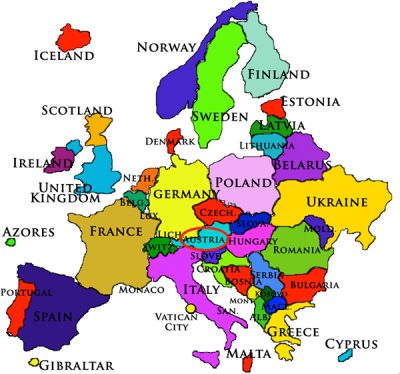
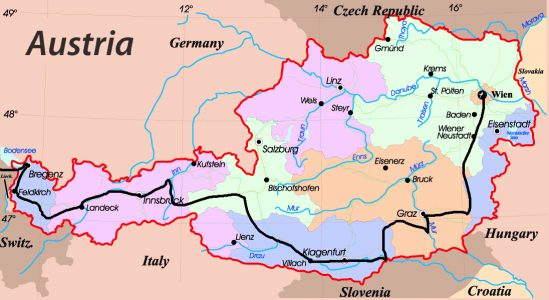
Living in the centre of Europe means that we don’t have to rely on air travel to go places. An 8-hour train journey took us from St Gallen to Vienna, short before the Slovakian border at the far eastern end of the country.
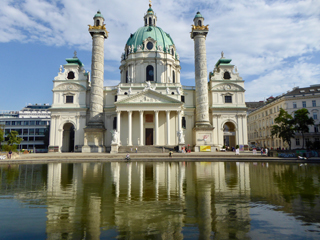
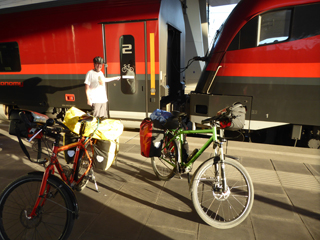
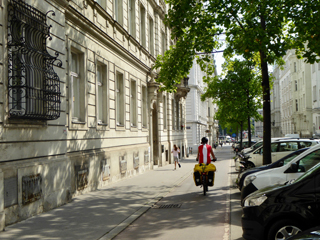
There, we were joined by our good friend Caitriona, from Ireland, as we explored this magnificent city with palatial architecture and elegant cafés, where the artists of yesteryears have given way to the tourist hordes of today. The Habsburg dynasty ruled most of Europe from here until the end of World War 1, and their legacy forms the backbone of Austria’s amazing capital city on the Blue Danube.
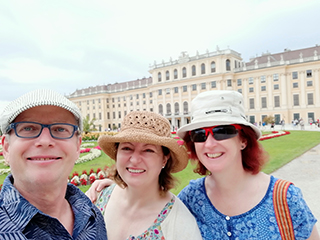
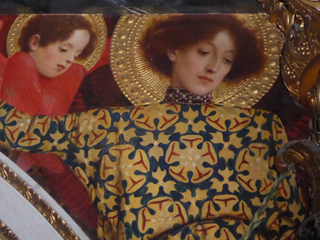
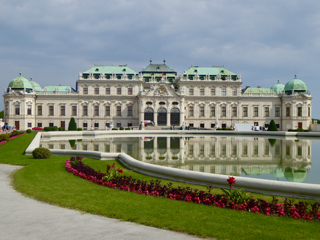
After indulging in what Vienna has to offer, it was time for relaxation in the form of a special spa resort designed by Austria’s famous Friedensreich Hundertwasser (1928-2000). In one of Austria’s poorest regions, while drilling in the hope of finding oil in the 1980s, all they found was hot water. The locals jumped on the opportunity and with the help of a local business man, Robert Rogner, Bad Blumau was born. Now employing 400, the area is booming, and the resort is a treat not to be missed.
Hundertwasser, famous for his use of vibrant colours, tiles and spirals, had a horror of straight lines, and advocated environmentally-friendly architecture. Bad Blumau’s numerous buildings are perfect examples of standing out and blending in!
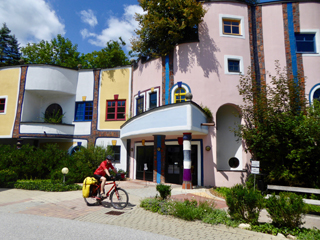
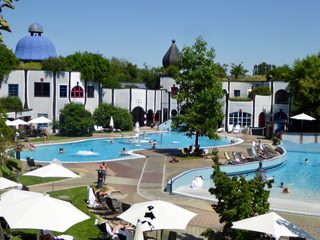
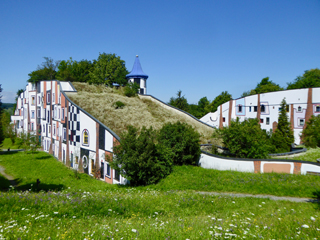
A short spin brought us into Graz, Austria’s second biggest city and the capital of the Styria region. Its 50,000 students are well-catered for with oodles of cafes and eateries, and the atmosphere is very laid back. Beyond splendid neo-classical and baroque buildings, Graz boasts a number of special modern additions. The Island on the Mur river, designed by New York artist Vito Acconci, is a unique shell-shaped café floating on the river and connected by bridge to each river bank.
The modern art gallery, known as the friendly alien, appears from above more like an octopus entangled in the red roof landscape. Designed by Peter Cook and Colin Fournier for Graz’s European capital of culture in 2003, it has become quite an icon.
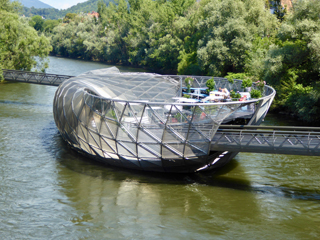
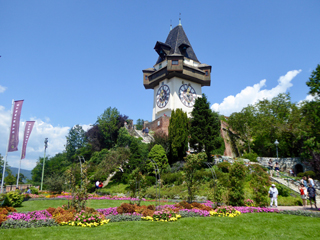
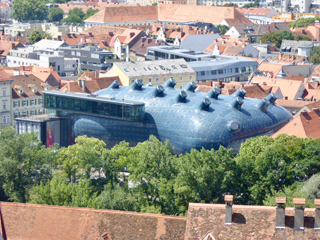
The Styria region is famous for its pumpkin-seed oil and we cycled passed acres and acres of pumpkin fields on a daily basis. They have been pressing this oil for over 300 years, while perfecting the crop so that the seed nowadays has a very thin skin rather than a tough hull, facilitating the process. They are so proud of this roasted oil that salads are served swimming in the greenish-black stuff!
This area is also renowned for breeding the Lipizzaner horses for the Spanish Riding School in Vienna. We were reminded about this every 500m, but beyond a lone farmer out with his working mare, there wasn’t a member of the equine species to be seen far or wide. Come to think of it, there weren’t any in Vienna either! Summer vacation supposedly! We’re sure Caitriona could put you in the picture though, being an artist and all!
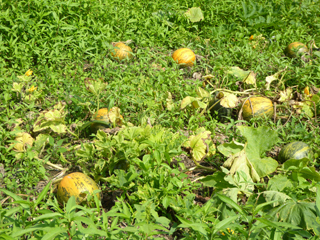
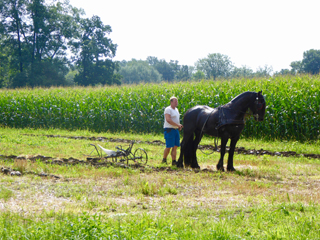
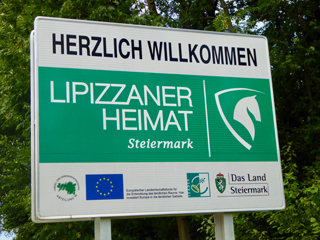
Still impressed by Hunderwasser, we did a little detour to Bärnbach to see how he remodelled the exterior and grounds of the local Santa Barbara Catholic church. Besides his hallmark colours and pillars, Hundertwasser included 12 gates throughout the grounds to represent various world religions as a symbol of tolerance and togetherness. The interior, in contrast, was in total compliance with corporate identity requirements!
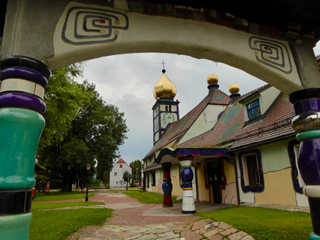
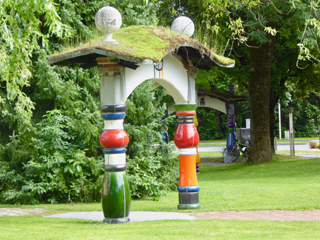

Pretty much every time we changed Bundesland (county), we had to climb a mountain – some higher than others. On the lovely downhill from Styria into Carinthia, Darina was stung by a bee. The sting developed into a nasty piece of work that required antibiotics and had passers by giving her wide berth until the rash subsided! Carinthia is famous for its many beautiful lakes, and the half of Austria seemed to be on holiday there. As temperatures rose, we were happy with the odd dip.


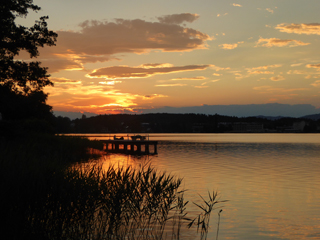
The River Drau led us into Villach, where we were spoilt rotten by Bala and family. We initially met Bala and his friend Tobias on a cycling trip in southern India, and then again in Sri Lanka. Tobias wasn’t around, but he very generously left his apartment at our disposal, while Bala shuttled us up to various viewpoints, his wife Kavitha cooked up a storm and his children, Eesan and Param, saw to it that there was never a dull moment!
Our morning in Klagenfurt was very well spent visiting the historic Crest of Arms Hall and the old town, before admiring the beautiful Woerthersee from the Pyramidenkogel observation tower and jumping for joy on the Villach Alpine road!
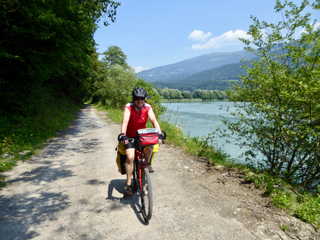
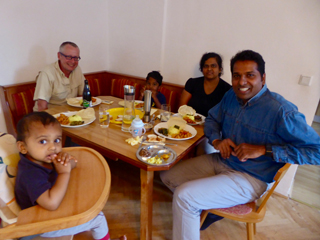
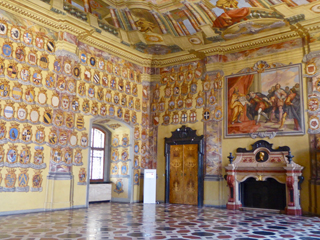

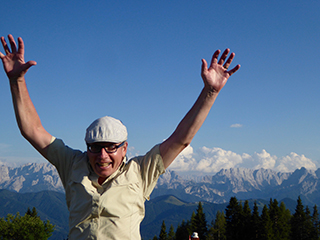
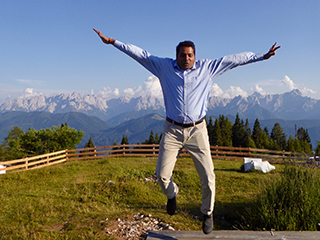
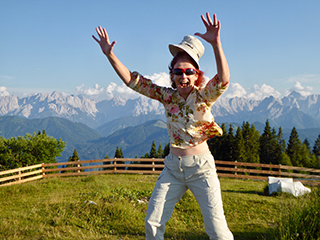
We approached Grossglockner, our highest pass, gingerly. The plan was to climb on Monday to avoid the traffic, so we had three short days to get to the base of the pass. The weather was overcast, but perfect cycling weather (for Darina!). We had time for a little sightseeing en route, including a hike through the impressive Ragga Gorge in Flattach. On Sunday, we had reached Heiligenblut (Holy Blood) at 1,288 masl.
The story goes that in 914 AD a Danish prince, while bringing home a little flask of the Blood of Christ from Constantinople, got killed in an avalanche in this neck of the woods. As it happens, the same lad, being savvy with regard to highway robbery, had stowed the flask in a self-inflicted wound in his calf. When his body was discovered, the relic was found safe and sound, and today it is kept in the local church. Rome refused sainthood, but the locals saw to it that the Dane was laid to rest in an avalanche-proof crypt.

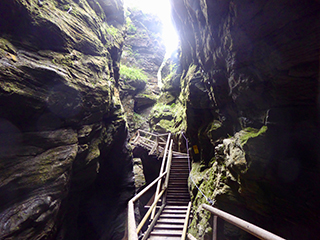
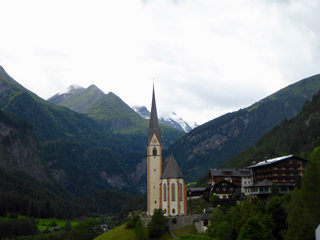
Our plan to avoid the traffic worked, but not because of the day of the week, as we learned on Tuesday. It was the rain that gave us a relatively peaceful ascent. Relatively being the operative word, as strong gusts of wind forced us to the centre of the road, for fear we might have to share that blessed crypt with the misfortunate Dane down in Holy Blood!
After a well-deserved picnic at the Hochtor (2,504 masl), we were absolutely frozen and could scarcely control the bikes for the short downhill before the second pass. Cold and wasted we found a hotel room to warm us up before dinner. The clouds had rolled in and we could have been anywhere!
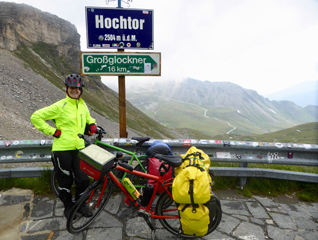

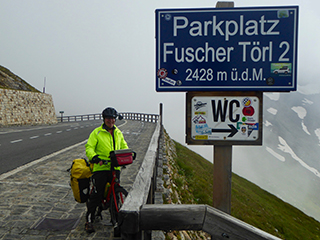
The next morning offered the spectacular panorama that was hidden all day Monday. At 5.30am we were already out with our cameras to capture the glorious views. After a hearty breakfast, we conquered the last 150 altitude meters up to the Edelweissspitze (2,572 masl) for a 360-degree view. By then, sightseers were arriving in their droves (who could blame them?), so we descended while the going was good!

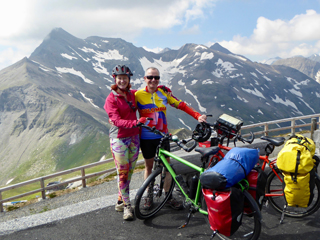
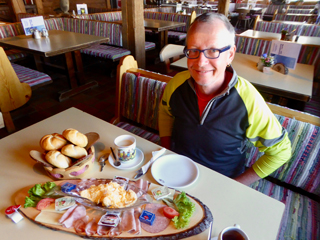
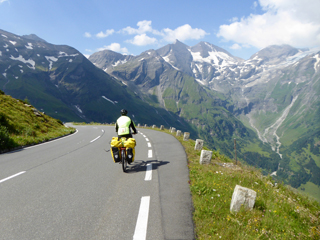
By the time we reached Zell am See, temperatures were 30 degrees higher! Setting up camp, one of our Exped mats gave up the ghost, so the rest of the afternoon was spent hunting for the only replacement in town. Incidentally, back home, Exped generously extended the warranty from 2 to 6 years and replaced our mats free of charge. Happy campers!
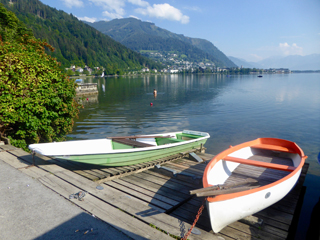
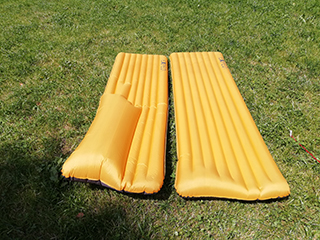
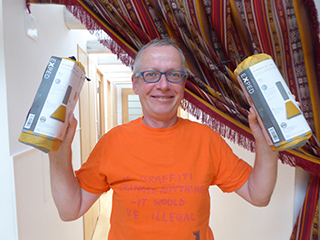
Our ascent to the Gerlos Pass offered views of the famous Krimml falls, while on the other side we enjoyed snacks & drinks with Lake Durlassboden as a perfect backdrop. Then came an impressive downhill punctuated by the search for a historical barn. Kurt describes his failed trip down memory lane below.
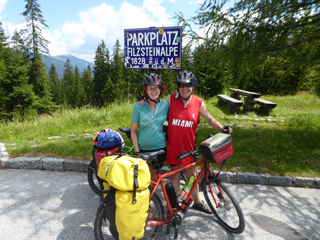
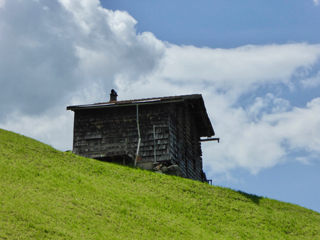

In my younger years, I used to tear over the Gerlos and Grossglockner passes on my motorbike, trying to reach Greece asap. I always shacked up in the same barn on the way down and back. I’d hide the bike behind it and snuggle up into the hay until first light. It could be the barn you see in the picture above. What surprised me was that I didn’t recall any of the roadside vistas: No Krimml falls, no mountain views. I couldn’t even point the finger with a semblance of conviction at the barn I used to frequent. Seriously, I think my memory is quite reliable, and this was my emotional escape route for years. Yet, I drew a total blank.
One possible explanation is, of course, speed. If you race down 2,727 km in two and a half days, your survival depends on your capability to focus on the road. Now, if the road is winding its way up and down mountains, there is less capacity for distraction. Another reason could be the fact that over time my escape routes have multiplied, and now I have layers and layers of information without the archeological tools to rediscover these gems of my past. Memory is a strange thing. Why do we still remember insults and humiliations that we have tried to forget for years. Maybe trying to forget is a way to etch experiences deeper into our personal data sheets?
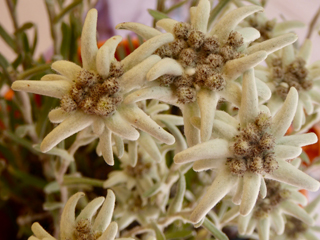
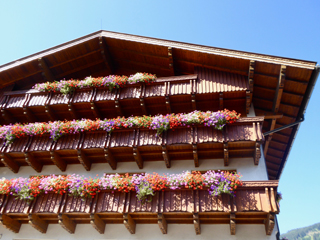

From then on, it was all river bicycle routes along the Ziller and the Inn to Innsbruck, the charming hub of the area. Instead of camping miles from the center Kurt decided to upgrade from a rough and ready barn to where Mozart himself stayed in 1769! The man has class. Kurt, of course! This Weiss Kreuz Hotel has been doing business for a good 500 years now and is not even the oldest place in town.
Actually, most historical hotels in Innsbruck have a colour and an object/animal in their names and a sign displaying the same: The White Cross, the Black Eagle, the Golden Crown. As an important trading town on the north-south axis, this made it easier for illiterate traders to find the lodging that had been arranged for them.
A wander through the old town and its arcades is a must, but what draws the crowds is the Golden Roof added to a balcony by Emperor Maximilian 1 in 1500 AD, so that he would never be forgotten! Innsbruck’s special location just 20 minutes from the spectacular Nordkette mountain range & ski slopes ensures that Maximilian is the topic of conversation on a daily basis year round.
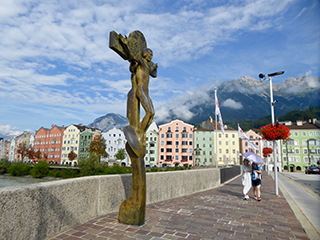
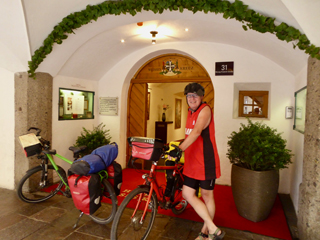

Further up along the River Inn, the bike route was at times squeezed in between the river and motorway, but also continued on quiet sideroads and purpose-built paths that went up and down and in and out, providing an even tan, along with a few nice views. Not all signs pointed in the right direction, as we discovered when we ended up on a steep forest single trail before having to climb over gates, to get back to civilisation. It was a hiking path to Santiago!

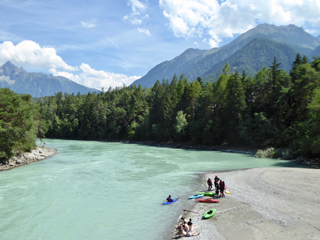
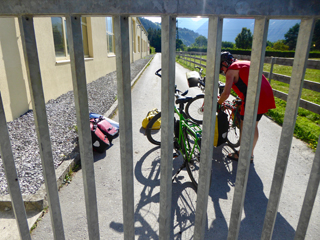
The Silvretta Hochalpenstrasse was our 3rd mountain pass of the trip and the beautiful scenery on the ascent was quite reminiscent of the Helgeland region of Norway. With temperatures topping 30°C we took it easy on the uphill and enjoyed the impressive 30 switchbacks on the descent.
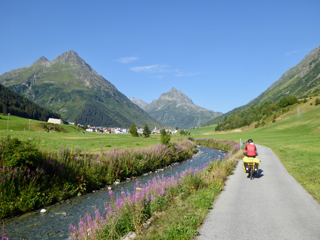
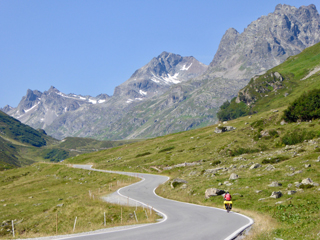
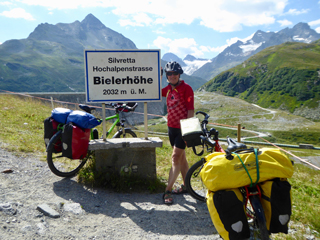
Our last destination was Bregenz, where we camped at Lake Constance and had a swim before sheltering from a serious thunderstorm. Alas, not all tents weathered it as well as others.
As a final homage to Hundertwasser, we swung by his Market Hall in Altenrhein (Switzerland) on the way home, before climbing the last hill to St Gallen.

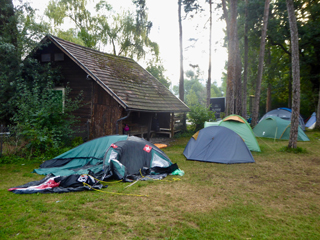
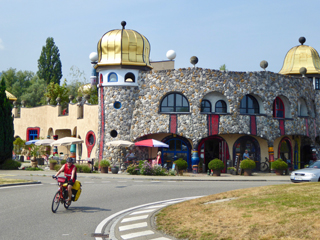
Apart from pumpkin-seed oil, Austria does have a number of other culinary specialities. Vienna is, of course, famous for its Wiener Schnitzel (breaded veal), served with potato salad or french fries. Then there are the more substantial dishes with blood sausage, pork and knödel (dumpling of mashed potatoes or breadcrumbs), Tafelspitz (boiled beef) and Zwiebelbraten (braised pork). The portions were usually so generous that we rarely had capacity for Palatschinken (pancakes), Apfelstrudel or their associates in the dessert department.
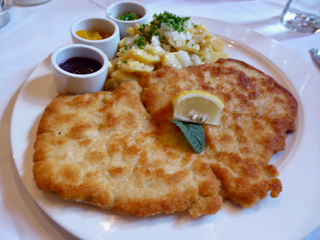
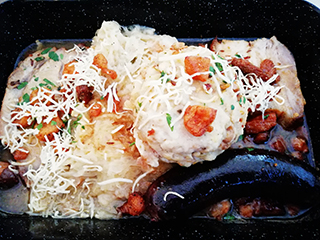
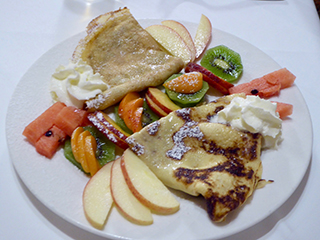
Camping, when available, was on the pricey side at 20-30€/night for 2 adults and a tent. B&B started at 70€ for 2 adults, but city prices could easily reach double that. The service was great, the breakfasts substantial and we had no cause for complaint.
The Austrians are famous for their hospitality, which we found most notable in Carinthia, Salzburgerland, Tirol and Vorarlberg. Traditional costumes are widely worn. They even go clubbing in their Dirndls! And if that doesn’t blow your skirt up, you can always go to a pig race!
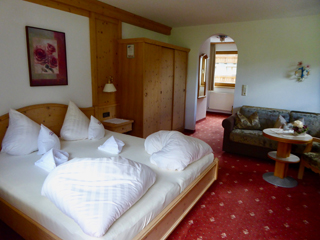

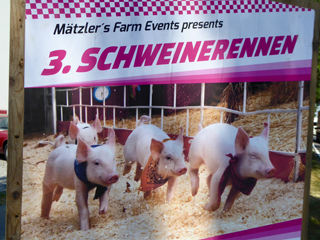
Austria is criss-crossed with bicycle routes and it is estimated that 25% of tourism is connected in some way with the bicycle. We followed numerous official routes over the three weeks:
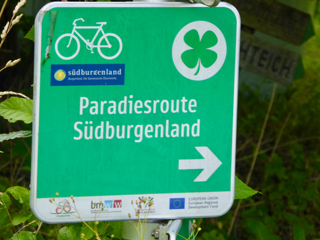
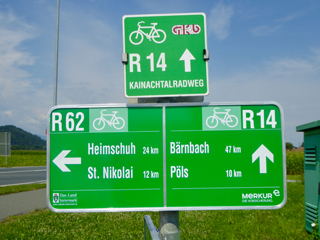
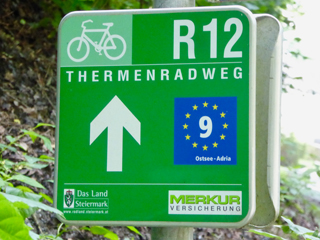
Our trip hovered between pleasant and spectacular. Being on our doorstep, Austria is not exactly exotic for us. However, the well-signposted bike routes, historical cities, friendly folk, good food and mostly beautiful weather made it a holiday worth reporting. We can recommend Austria as a cycling destination for both families and sports enthusiasts, as there is something there for everyone. Check it out!
